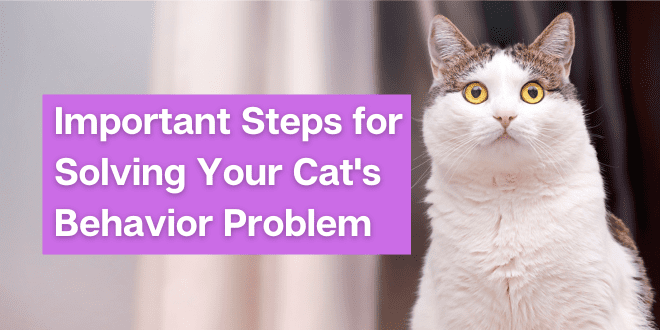
Cats are smart. They’re also exceptional at communication. Where cat parents often fail in avoiding or correcting behavior problems is that they misinterpret or discount what is being communicated. Many cat parents label unwanted behaviors as misbehaviors that must be stopped or punished. Behaviors are repeated because they work. The result of the behavior might not be pleasing to human family members, but it makes sense to the cat. That’s a central fact frequently overlooked. Attention isn’t paid to why the behavior is being displayed, but rather, the focus is on the external appearance/outcome of the behavior. When the cat eliminates on the bedroom carpet it certainly upsets cat parents, but it most likely works for the cat because he might feel safer there. After being ambushed by a companion cat whenever he tries to get to the litter box, he may determine the bedroom keeps him out of harm’s way. The human family members look at the behavior as being bad, and the cat looks at the behavior as being critical for safety.
Animals repeat behaviors that work for them, regardless of whether you agree with the behaviors or not. The key to solving the problem? Change your point of view. Look at it from the cat’s angle. What does the cat achieve from the behavior and how can you set things up for success? Maybe it means you need to increase the number and locations of litter boxes or work on a behavior plan to help companion cats get along better. It may require you to reevaluate the location and number of other resources in the environment and make modifications that better meet the needs of the number and personalities of the cats in your home. Whatever the specific problem is, look at what the cat gets out of the behavior.
Four Important Steps for Correcting Your Cat’s Unwanted Behavior
Avoid getting caught up in wrong assumptions regarding a cat’s motivation. Don’t label a cat because of a behavior instead of realizing it’s a natural behavior or a reaction to a particular circumstance. Focus on how cats communicate, what they need, and why they display behaviors. Don’t fall into the trap of labeling a cat as bad, spiteful, stupid, mean, or untrainable.
Look at what a cat is doing and the circumstances surrounding the behavior:
- What behavior is being displayed?
- What are the circumstances?
- What is the cat getting out of the behavior?
- How can you change the outcome or provide a better alternative?
When you look at the conditions surrounding a behavior it sets you up to identify possible antecedents. Identify those and then change the conditions. If the cat bites you every time you pick him up, for example, instead of labeling the cat as mean and punishing him for biting, look at the possible trigger.
- Was your approach incorrect?
- Had the cat clearly indicated no interaction was wanted?
- Did you startle him?
To create a better outcome, create a better set-up. Also, pay attention to what the cat communicates as you hold him.
- Is he possibly in pain?
- Did you ignore signs indicating he was approaching his tolerance limit?
- Did you continue to hold him even after he communicated that he wanted to be released?
- Did he feel the only way to get you to release him was to bite you?
Perhaps you didn’t give your cat any choice about whether interaction was wanted, and/or when he wanted it to end. Choice is important.
Don’t Punish Your Cat
Many people reprimand the cat for misbehavior. Instead of focusing on what the cat needs and how to help him succeed, some cat parents, out of frustration, choose punishment. Imagine the stress the cat endures when he’s punished for a behavior that’s normal and essential in daily life. Punishment does nothing to teach the cat anything other than to be afraid of the cat parent. For example, the cat stops using the litter box and starts urinating on the carpet in the dining room. The cat parent who punishes (rubbing the cat’s nose in the mess, hitting, yelling, time-out, or forcing the cat into the litter box), has only succeeded in elevating the cat’s fear and stress to an unhealthy level. What if the cat was eliminating outside of the box because he was in pain due to a medical problem and associated the box with his pain? Because he will now associate punishment with the need to eliminate, he is not only in pain from the medical condition, but scared and uncertain about where to pee or poop. For the cat parent, the intended message was that the location choice for elimination was wrong, but the actual message the cat received was that urination is bad and will result in punishment and fear. Since the elimination need will arise again, fear may drive him to retain urine as long as. He may also seek a more remote and hidden place for elimination to avoid punishment. Either option causes even more worry to an already stressed-out cat.
Punishment only temporarily stops a behavior – it doesn’t stop the need for the behavior. Your job is to determine the why behind the behavior to resolve it effectively with love and compassion. If you view what your cat does as a misbehavior, you won’t be a successful problem solver.
Visit the Veterinarian
You may be confident a problem is strictly behavioral but there’s a good chance a change in your cat’s normal behavior could have a medical cause. Have your cat examined by the veterinarian. This needs to be the very first step to rule out any underlying medical reason for the unwanted behavior.
After your cat has been examined by the veterinarian, you can begin to tackle this from a behavioral position. I wrote the book, Think Like a Cat, because I had seen so many people interpret behavior problems from the wrong perspective. Cat parents were labeling unwanted behaviors as intentional misbehaviors. As a result, their attempts at solutions were ineffective and only added stress to the entire household. The best techniques are based on what cats need and to create an environment that allows them to engage in natural behavior. Look at all behavior from a think like a cat aspect for effective and compassionate problem-solving.
Don’t Wait for Your Cat’s Behavior Problem to Get Worse
If you notice something that doesn’t seem right or suspect the beginning of a problem, act on it before it gets more serious. The sooner a problem is addressed, the better the chance of success. By addressing it early, you greatly reduce the amount of stress your cat goes through. Stress is the nemesis in a cat’s life and if left unchecked, can lead to medical concerns.
When I do consultations in multicat homes, I find cat parents have waited a long time before contacting me because they didn’t recognize initial signs of cat-to-cat tension. Because they didn’t see actual fighting, they assumed the cats were all getting along. I also notice many people with multicat households haven’t provided individual personal core areas for each cat or social group within their household. Many cat parents with larger cat households didn’t even recognize different social groups existed. They unwittingly set their cats up to compete, intimidate, and live in continual stress.
The Road to Successful Behavior Training
Create a behavior plan that clearly defines what you want the cat to do instead of the unwanted behavior and how you can get him to select that. Give him a better option. Keep everything positive and reward him when he succeeds. Pay attention to what your cat is communicating. Behavior doesn’t occur in a vacuum.
Work on Rebuilding the Bond
If your cat has been punished or if the behavior problem has caused a divide between the two of you, work on mending the bond. Even if the behavior has you frustrated and you don’t feel warm and loving toward him right now, this is the exact time you should work on restoring trust. Conduct interactive play sessions to alleviate stress (it’ll help both of you), spend time together and rediscover the good relationship. Your cat needs you to provide security and reassurance.
Acknowledge Your Cat’s Good Behavior
Reward behaviors you want to see again. This is something many people forget to do. No matter how small of a positive step in the right direction, it’s still forward motion so acknowledge it. This is where clicker training is very helpful. Clicker training is fun and easy to learn. You can also easily acknowledge with praise, petting, playtime, or a tasty little treat. Find what your cat views as the best reward. Every cat is an individual.
Be Patient
Correcting a problem behavior isn’t a quick fix but the reward is worth the time. Tragically, many cats end up in shelters because families don’t realize behavior problems can be corrected. Too many cats are relinquished to shelters for behavior issues that could’ve been resolved or shouldn’t have become problems in the first place. Don’t give up on your cat! Educate yourself on how cats think and what they need. It’s never too late.
Get Help from A Professional if You Feel Overwhelmed
Some behavior problems may be beyond your ability to correct without professional guidance. If the problem is too critical, dangerous, or you don’t feel you can work on it yourself, contact your veterinarian for a referral to a certified cat behavior expert. There are many people on the internet claiming to be experts and whisperers, but they lack true credentials, ethics, and experience. Make sure the behavior expert has professional credentials because an unqualified person can make the situation worse. Ask your veterinarian for a referral to a veterinary behaviorist, certified applied animal behaviorist, or an IAABC-certified cat behavior consultant.
There are many resources available and the number of certified behavior professionals throughout the world increases every year. If there isn’t a certified behavior professional in your area, many will work with you and your veterinarian through virtual consultations.
Need More Information?
For more specific information on cat behavior and training, refer to the best-selling books by Pam Johnson-Bennett, The books are available at bookstores and online. Links to Amazon are included on our website.
If you have a question regarding your cat’s health, contact your veterinarian. This article is not intended as a replacement for your cat’s veterinary care and is not dispensing medical advice.




